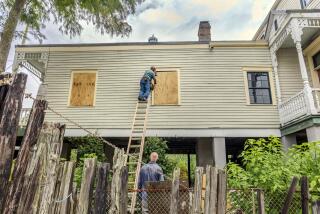A Sleepy Baton Rouge Wakes Up a Boomtown
BATON ROUGE, La. — Galatoire’s, the celebrated restaurant that has long epitomized the epicurean pleasures of New Orleans, reopened last month in the French Quarter. But in a stucco shopping center 75 miles upriver, discriminating diners already were savoring its famous trout amandine.
Galatoire’s Bistro opened here on the outskirts of the state capital in November, and New Orleans took the news as a civic shot to the gut. The story in the Times-Picayune began, “First the storm, then the floods. Now hell is apparently freezing over. Galatoire’s is opening in Baton Rouge.”
To many of Baton Rouge’s business and government leaders, however, the arrival of Galatoire’s underscored change that was occurring even before Hurricane Katrina devastated New Orleans. Baton Rouge, or BR as it is sometimes called locally, has been growing in size and economic stature for more than a decade, while the Big Easy has been shrinking.
With much of New Orleans still in ruins, Baton Rouge seems destined to become Louisiana’s population and business center -- even if it never comes close to New Orleans in art, food, music or tourism.
“Baton Rouge has come a long way,” said Justin Galatoire Frey, who moved to Baton Rouge to run the family’s new restaurant. “A lot of people said Baton Rouge couldn’t support something like this, but business has been very good. I think Baton Rouge is going to be bigger for a while, I really do. It’s going to be a long time before New Orleans ever gets back the population it had, if it ever does.”
Louisiana’s capital historically occupied a spot in the municipal hierarchy similar to the relationship Sacramento has shared with San Francisco -- languishing in the shadow of its bigger, more cosmopolitan neighbor.
One of Baton Rouge’s top attractions remains the castle-like Old State Capitol. Built in the Gothic style in the mid-1800s, it was ridiculed by Mark Twain as “the ugliest thing on the Mississippi.”
Perhaps best known as the home of Louisiana State University, this once-sleepy city of 227,000 is overflowing with an estimated 100,000 hurricane evacuees -- and local officials say that as many as half might stay for good.
New Orleans, by contrast, is housing about a third of its former 484,000 residents, and continues to struggle to rebuild.
“There is no way to know how many of these folks plan to stay,” said Hampton Grunewald, executive assistant to the mayor-president of Baton Rouge, Melvin “Kip” Holden. “But the assumption everyone seems to be making is that many will remain.”
Baton Rouge business leaders take pains to point out that they are not attempting to boost their city’s fortunes at the expense of New Orleans. But the Baton Rouge Area Chamber has hired a consultant to help lure businesses that are considering leaving the Big Easy, arguing that it is better to keep them in Louisiana than watch them move to Houston or Dallas.
The chamber predicts that the nine-parish greater Baton Rouge region will gain up to 35,000 new jobs over the next three years and could soon top 1 million people.
National homebuilders have begun sizing up surplus land in the Baton Rouge area, speculating that housing could soon become a hot commodity. Commercial real estate developers are discussing plans to build as many as five office high-rises in downtown Baton Rouge.
Echoing Galatoire’s move, Mandina’s -- a fixture on New Orleans’ Canal Street -- recently opened a branch in Baton Rouge. The comfort food restaurant is drawing standing-room-only crowds.
“There was a perception in New Orleans that in Louisiana, there was New Orleans and then there was the country,” said Charles Landry, managing partner of the Baton Rouge branch of Jones Walker, Louisiana’s largest law firm. “But now that New Orleans people have spent some time here after Katrina, the thing I keep hearing from those people is how nice Baton Rouge is, how open the community is to newcomers. And I think that is why people are staying.”
Landry said it was “highly unlikely” that Jones Walker would expand its New Orleans office, which employs about 150 lawyers, but “clearly we will be expanding our Baton Rouge office. That was already happening, but it has been accelerated by a decade.”
Yet amid the boomtown hoopla, there is concern that Baton Rouge may be becoming too big for its own good. Many citizens fear the rapid growth that seems inevitable could change the city’s character for the worse.
“So many people opened up their hearts and homes to people from New Orleans after the hurricane. But I think one of the reasons people live here is because of that small-city feeling, and it would be terrible if that changed,” said Tina Wood, a Baton Rouge resident sitting outside a Whole Foods Market with her 16-year-old daughter, Sabrina.
Baton Rouge authorities said no significant increases in violent crime had occurred despite the recent jump in population. The city experienced two more homicides last year than the year before.
“Our calls for service and demands on our people are way up. But we are proud of the fact that while there have been some hardships, this hasn’t caused our crime rate to go way up,” said Baton Rouge Police Sgt. Don Kelly.
Still, religious leaders and community activists are worried that Baton Rouge could experience an epidemic of homelessness now that the Federal Emergency Management Agency is ending taxpayer-funded hotel rooms for hurricane evacuees. The St. Vincent de Paul Society, which operates three homeless shelters and a dining room in the region, has reported a sharp increase in visitors.
“We know they are there in those hotels and they’re going to need housing soon, so we have been looking at affordable housing,” said Randy K. Nichols, executive director of the Capital Area Alliance for the Homeless.
Holden, the mayor-president, recently declared that he would not allow any more shelters to house evacuees, arguing that the burden needed to shared by other cities.
There are also tensions simmering over the temporary trailer villages that FEMA has set up throughout the Baton Rouge area for evacuees. Many residents worry that the trailer sites will morph into permanent settlements.
“The supposition is that they are only here 18 months, but the reality is that they may be here forever,” said John Spain, executive vice president of the Baton Rouge Area Foundation, a nonprofit group that manages more than 300 charitable funds. “Some people have referred to them as ghettos, and I don’t think they are there just yet, but they do have the potential to become ghettos.”
At the largest of the trailer settlements, an encampment of about 600 units dubbed Renaissance Village just north of Baton Rouge, neighbors are complaining of problems.
“It really boosted sales at first, but now I keep having to run people out of here,” said Paul Bergeron, owner of a sandwich shop near the trailer site.
Overhearing the conversation, customer William Price, 44, chimed in, calling the Renaissance Village a “crack-head training camp” and a detriment to the community.
If there is one urban ill that has indisputably upset Baton Rouge residents, it is traffic. Molasses-thick snarls have become a fact of daily life and a constant source of complaint.
“There have been comparisons to Houston,” said Scott Windom, 23, an LSU information systems student, making clear that any similarity was unwelcome.
Yet growth has also brought Galatoire’s. And although bistro diners concede that the Baton Rouge branch doesn’t come close to matching the vivacious spirit of the original, trout amandine at Galatoire’s Bistro is just a short drive away.
More to Read
Sign up for The Wild
We’ll help you find the best places to hike, bike and run, as well as the perfect silent spots for meditation and yoga.
You may occasionally receive promotional content from the Los Angeles Times.






